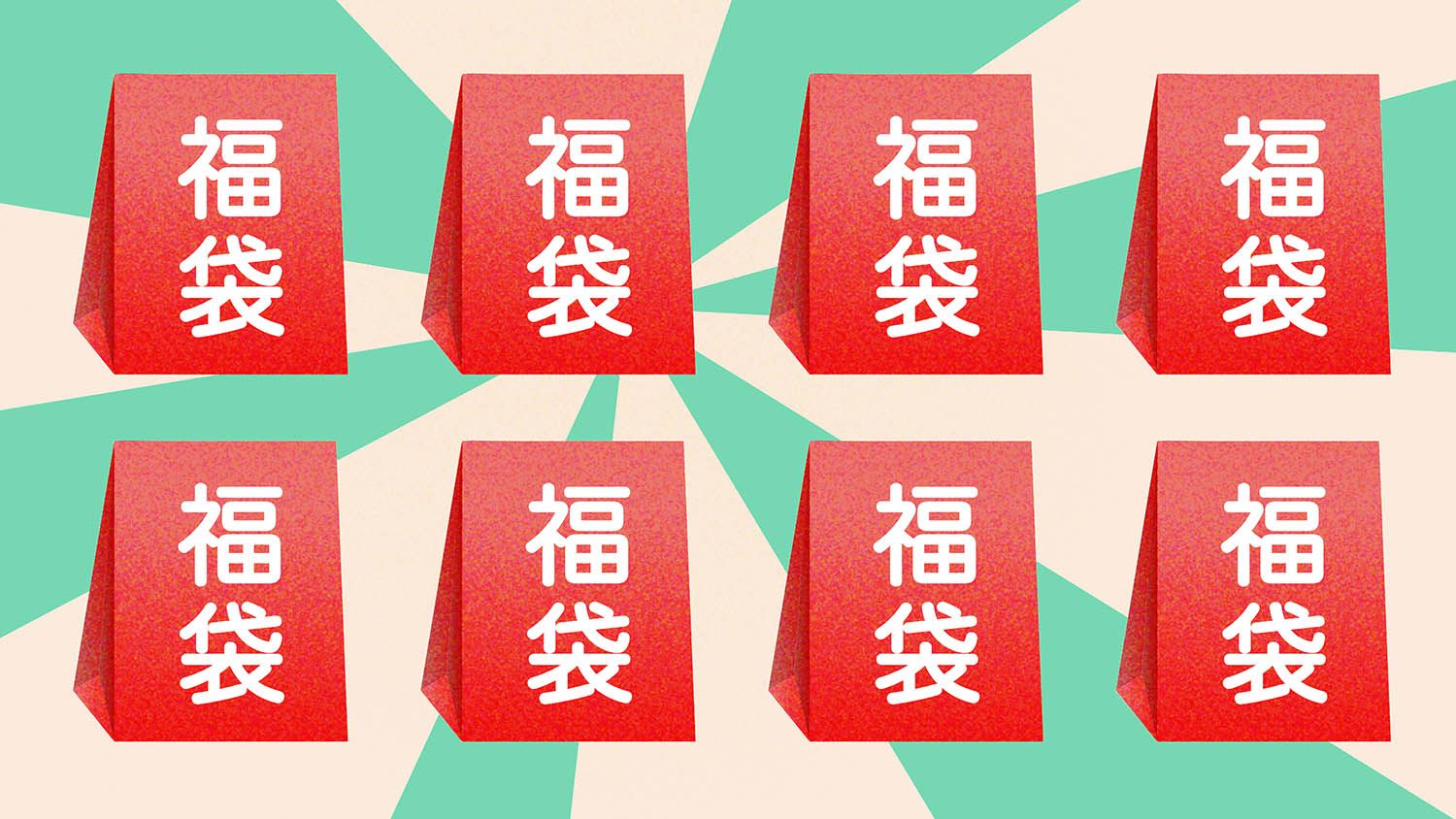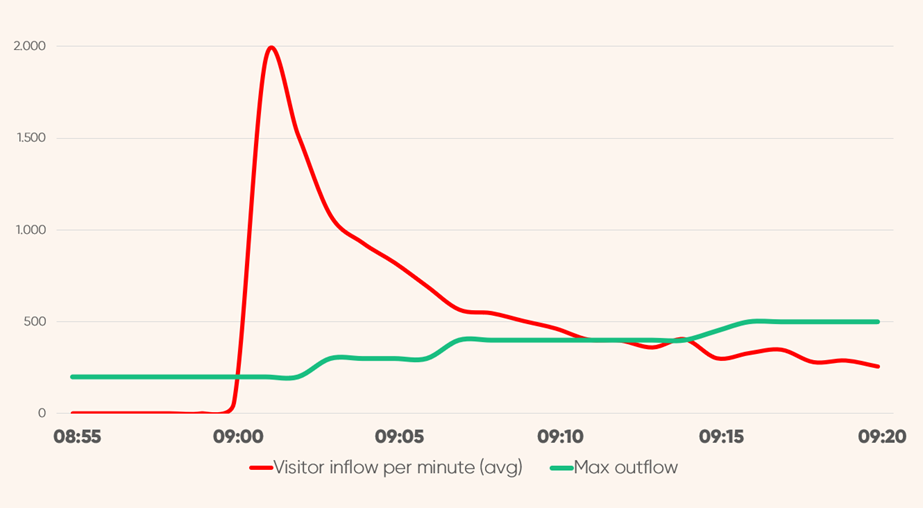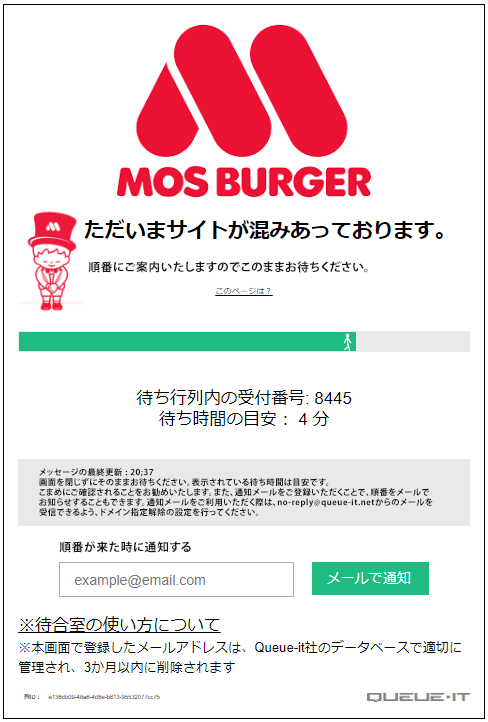“Never start a customer journey poorly”: MOS delivers hospitality for 50 years

MOS FOOD SERVICES is the operator of MOS BURGER franchise, one of Japan’s first and largest burger chains. For over 50 years, MOS has been laser focused on high quality food and hospitality to match. But expanded online sales and a particularly popular promotion presented a challenge of how to replicate the experience online. Discover how MOS teamed up with Queue-it to bring the reliability, hospitality, and convenience their customers have come to expect into their online store.
MOS BURGER opened its first store in 1972. It was under 30 square feet and one of Japan’s first burger shops. Fast forward 50 years and MOS is one of the top fast-casual dining chains in Japan, with approximately 1,300 stores in Japan and 400 abroad.
MOS’ rise to success was no accident. They’re completely committed to ensuring a high-quality menu and customer service to match.
Unlike many chains, MOS only prepares food once it’s been ordered, and they work closely with over 3,000 farmers across Japan. At every MOS BURGER restaurant, you’ll find a blackboard showing customers where the ingredients are sourced from, and the farmers behind their delicious meals.
But the burger business has changed a lot since 1972. It’s not only grown in competition but has also shifted online.
For MOS, a brand committed to high-quality customer service and hospitality, this shift posed several challenges, including how to maintain their high standards of service and reliability in new digital spaces.
Rising to the challenge are Ryobun Morinaga and Jun Hasegawa at MOS FOOD SERVICES’ Digital Promotion Department. We sat down with them to discuss MOS’ shift to online ordering, their lucky bag promotions, and how they use Queue-it to ensure their site performs just as their stores and staff have for 50 years—efficiently, reliably, and hospitably.
MOS Burgers’ lucky bag sales are among their most popular events. A Japanese New Year retail tradition, lucky bag sales involve merchants creating bags filled with random assortments of goods and selling them at a discounted price.
MOS’ lucky bags combine customers’ favorite meals with special limited-edition merchandise. They’re a great brand touchpoint for loyal and new customers alike. During the pandemic, MOS’ lucky bag sales shifted to be sold exclusively online. And in 2022, they decided to expand the lucky bag promotion, running sales in the spring and summer for the first time ever.
At the request of customers, who wanted a fair chance of getting their hands on a lucky bag, MOS announced the newest lucky bags would be launched at a specific date and time. “Previously, we’d just announce the date of the sale. But after many requests from customers, we decided to announce the specific time of the launch too,” says Morinaga.
For the MOS’ first ever spring lucky bag sale, they collaborated with Kirby, one of Nintendo’s most popular characters. The sale announcement and promotional images built massive hype, with fans of Nintendo and MOS raving about the lucky bags on social media.

The Spring lucky bag sale was the first MOS ran after publicly announcing the date and time of the launch. So, on April 6th, when the clock hit 9AM, traffic to MOS’ website surged.
“The number of orders per day didn’t differ much from the previous sales. But the traffic spike in the first few minutes was far above our expectation,” Morinaga tells us. The massive traffic spike crashed the website, delaying the sale by 2 hours.
According to Morinaga, “Frustrated voices surged on social media and the customer desk from people who kept loading the page in vain, and from those who could’ve only purchased the lucky bags at the announced time and had to give up. The voice of the consumer was unprecedentedly negative.”
As a company that prides itself on convenience, hospitality, and customer service, MOS did not take the situation lightly.
Finding a traffic solution before their summer lucky bag sale became the top priority for Morinaga’s team.
“Within the same day, we determined that we must, at all costs, avoid letting the customer journey start poorly.”
Ryobun Morinaga, Digital Promotion Department, MOS Food Services
For their summer lucky bag sale, MOS teamed up with a beloved Sanrio character, Pompompurin. As in the spring, the campaign generated enormous buzz, and Morinaga’s team was under immense pressure to run a smooth sale.
In preparation for the sale, MOS load tested their site to understand its capacity. They scaled up their servers to increase this capacity. And they implemented Queue-it’s virtual waiting room to ensure the site would remain online no matter the demand and customers would be given a fair and pleasurable experience.
Implementing the virtual waiting room was simple, says Hasegawa. “It was so easy that it could have been done in 2-3 days.” And configuring the waiting room in preparation of MOS’ summer event was even more straightforward.
“The interface of Queue-it was very easy to navigate. We usually outsource much of this kind of work to our vendors, but in this case, I could set up the traffic management for the event nearly by myself, with the support of Queue-it Japan team.”
In the first minute of the 9 a.m. launch of MOS’ summer lucky bags, almost 2,000 visitors rushed the site. In the next minute, another 1,500.

But this time, MOS was prepared. Rather than this surge of traffic bringing their site crashing down, visitors were throttled into the virtual waiting room. The waiting room was customized in MOS’ style, and gave detailed wait information, real-time message updates, and an email notification function.
It seamlessly throttled customers back to the site, 200-500 at a time, in a first-in, first-out order.

“The day went very smoothly,” says Morinaga. The site remained online and highly responsive, the orders were filled, and both MOS and their customers were pleased.
“We captured every sale without a crash or a delay. We saw many positive posts on social media about the waiting room, and hardly any complaints.”



Morinaga was initially worried about making customers wait. But after seeing the data in the Queue-it’s GO Platform and the feedback on social media, his worries disappeared.
“The visualized customer behavior on the GO Platform was very helpful. Before the sale, we expected the threshold of customers’ wait time to be about 5 minutes. But the abandonment rate was much lower than expected, even among customers who had to wait over 10 minutes for access.”
With MOS increasingly shifting towards an omnichannel business model, the Digital Promotion Department continues to build and improve their IT infrastructure and user experience. The issues from the spring lucky bag sales put these projects on hold, but with Queue-it in place, MOS could get back to developing and improving their online experience.
Using the virtual waiting room didn’t just free up the team to focus on other projects, it also proved a cost-effective solution. “Using your own resources to deal with temporary bursts of traffic just isn’t cost effective, so I think it’s better to use cloud-based services,” says Morinaga.
With control over traffic, MOS is back to focusing on what matters most: delivering the experience and hospitality their customers have come to expect, both on and offline.
“Prior to COVID, our staff could immediately address customers’ issues in person, but the pandemic made it harder for businesses to show their hospitality. I think now more than ever, we should aim to improve customer experience with the power of IT.”